Tips for Low-Waste Living
Air Date: Week of May 15, 2020
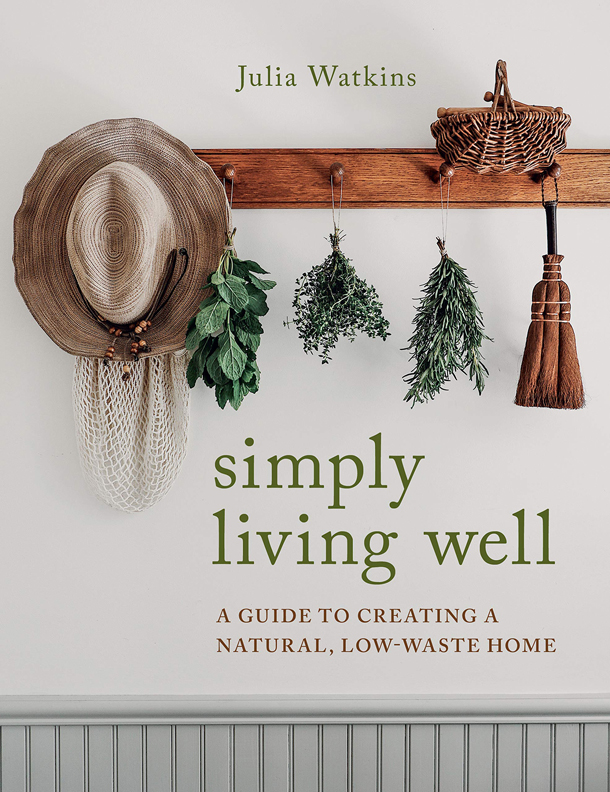
In Simply Living Well, Julia shares waste-reducing recipes, as well as instructions on how to make your own natural cleaning supplies and wellness products. (Photo: Courtesy of Julia Watkins)
Sustainable living can be as much about returning to old, thrifty traditions as it is about innovative technologies. Social media influencer Julia Watkins set out on a low-waste journey and discovered that food scraps can be repurposed in everything from soups to crackers to household cleaners. Julia Watkins is the author of the new book, “Simply Living Well: A Guide to Creating a Natural Low Waste Home” and joins Host Steve Curwood to share some of the recipes she learned along the way.
Transcript
CURWOOD: When Julia Watkins started thinking about food waste in her own home she took action to reduce her household waste and live more simply. She shares pictures of her low waste journey on Instagram and has amassed nearly a quarter of a million followers. And as a social media influencer she is now sharing some of her strategies and recipes in a new book, Simply Living Well: A Guide to Creating a Natural Low Waste Home. She joins us now from near Chicago. Julia Watkins, welcome to Living on Earth.
WATKINS: Thank you so much.
CURWOOD: A lot of people I imagine are starting out are looking again at the simplicity side of having really low waste, because we can't go anywhere. So in this moment, what are a couple of things that you would point out to people who really maybe haven't thought about trying to live the low waste or zero waste level--things that they could simply do right now in their homes in apartments, given the challenges that we have?
WATKINS: So my book was actually inspired by my great grandparents' generation. A lot of my style of low waste or zero waste is very old fashion. And, you know, they all survived the Great Depression by virtue of being resource conscious. So the recipes in my book are very, they're very within anyone's reach. For example, to make a veggie stock, you use scraps from the vegetables you've used for cooking throughout the week, so you don't have to go out and buy a carton of veggie stock, and you also don't have to buy new vegetables for it. When you make nut milk, you can use any kind of nut you have. You don't throw the pulp away at the end-- you use it to make crackers, you use it to make truffles. When you eat an orange don't throw the peel away--you can put it in a jar of vinegar and let it infuse for a couple of weeks and then turn it into an all-purpose cleaner.
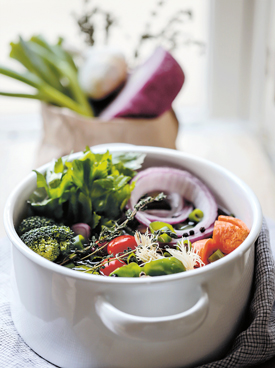
One of Julia’s favorite recipes is the vegetable stock she makes out of her kitchen scraps. (Photo: Julia Watkins)
CURWOOD: Or you could do what my grandmother did--make candy out of this stuff.
WATKINS: Really?
CURWOOD: Yeah, those orange rinds, those grapefruit rinds, they would candy them at the holidays.
WATKINS: I haven't try that yet, but I've wanted to. Yeah, you can use orange peels for all kinds of things.
CURWOOD: So you're really big on vegetable scraps. And in fact, you have a recipe for a soup made from vegetable scraps. So talk to me about that.
WATKINS: Yeah, when I first started going zero waste, I noticed a lot of people making this veggie scrap stock. So I tried to figure out a way to make it really delicious. And basically what I do is save veggie scraps and past-peak produce, I prepare veggies throughout the week, I wash and save stalks and peels and leaves, and then I store them in a paper bag or a mason jar in the refrigerator. And when I have about four cups worth, I make the stock. So it's not as easy as just throwing the stock in a pot with some water. You want to give it a really strong flavorful base. So just chop up a couple of onions, couple of carrots, some celery and some garlic and put a little oil in the bottom of your pot and saute them until they're tender. And then just all you have to do is add your four cups of scraps, eight cups of water, let it boil, then simmer for an hour. And that's it. That's your veggie scrap stock. You can let it cool and bottle it up in mason jars and put it in the fridge if you're going to use it that week or you can freeze it, too. It freezes for up to six months to a year.

Julia grows many of her own vegetables in a garden outside her house. (Photo: Julia Watkins)
CURWOOD: Then take me to the next step. So what do you get to use this for?
WATKINS: I use it in a lot of the recipes in the book. A lot of the recipes come from harvesting vegetables from my garden. So I use it for a carrot tomato soup. And I use it for an onion garlic soup that uses 40 cloves of garlic
CURWOOD: 40 cloves of garlic.
WATKINS: Yeah
CURWOOD: A little hot for the mouth, don't you think? No?
WATKINS: Well, you roast it and it takes a lot of the sting out. It's delicious. So I use it for that and we stir fry a lot at our house. So I'll use it for stir fries. I go through the stock pretty quickly. I usually make this every Sunday as part of my weekly rhythm.
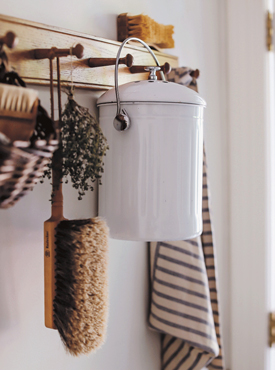
Julia considers traditional, old-fashioned cleaning supplies to be more beautiful than the more modern plastic ones. (Photo: Julia Watkins)
CURWOOD: Julie, in your new opinion, why should we be doing this? Why should we be trying to minimize the waste that we create on the planet?
WATKINS: Well, I think there's different ways to look at it. There's sort of the environmental reason. We know that we're extracting resources faster than is sustainable. We know that populations are growing and that eventually, things could get really difficult for people. For me. I know that I care about the natural world. I've had these wonderful experiences. For me, it doesn't come so much from my head. It's not so intellectual. It's a little more from like my heart, I guess, as cheesy as that sounds, but I've had these experiences. I do think I have a connection to the natural world. And it makes me feel good to be authentic to be who I say I am. And I think I've always said I would do this, even if we weren't in the midst of a climate crisis or a coronavirus. But it really, we have all the reason to do it if it's coming from an intellectual place.
CURWOOD: How do you reach people who are so driven by the brand, the label, the chicness, the being able to, what, we're moving ahead, aren't we? We must do something that's new and modern. How do you address those folks when they can look and see that so many of the things we recommend, come from, well, a century ago?
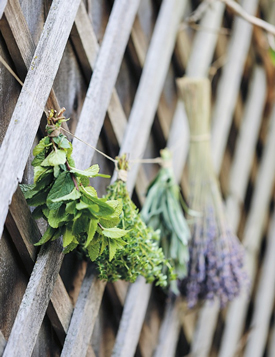
Home Grown Herbs (Photo: Julia Watkins)
WATKINS: I think you have to make it beautiful for those people. And it is beautiful. If you look at old fashioned cleaning tools, they're not made out of bright pink plastic poles or handles, right? They're made out of beautiful wood. And the bristles are made out of horsehair and real natural fibers. They're beautifully, they're aesthetically pleasing. I think a lot of people get into zero waste and natural living because of the aesthetics. And I think that's fine. Once they're there. Just try to keep them there. You know? But I think sustainability has grown because it is beautiful. And it does appeal to people's sense of style and personal aesthetic.
CURWOOD: And what would you say to folks who are now stepping into a very difficult time economically? How does your approach to natural low waste save money?
WATKINS: Well, a lot of the the recipes use what you already have. They use things that your grandmother used to when she was strapped for cash, too. They're inspired by the idea that you can grow herbs, you can dry them, you can preserve them, and then you can use them for every area of your home.
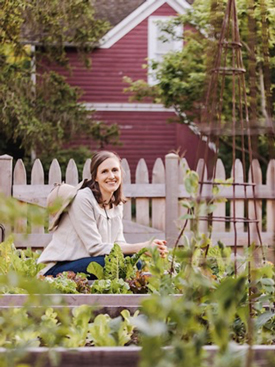
Julia Watkins lives near Chicago. (Photo: Courtesy of Julia Watkins)
CURWOOD: What inspired you to get involved in all of this?
WATKINS: I think mine happened in a lot of different stages. So my professional background is all in environmental work. I was a Peace Corps volunteer in a tiny little village in Guinea. And I saw people literally living in direct connection with the environment. And I saw them living simply and slowly. And I was so inspired by people just making do with what they had. So I think once my first child was born, and I was home for a while, I wanted to integrate everything I've learned through my education and my experiences with my actual life. That's when I started cooking with real ingredients and real food and one thing led to another. It was like a rabbit hole and then I was making my own cleaning supplies. And then I was growing a garden and learning how to sew and learning how to knit. And for me it was very empowering. I think sometimes people think of the 1950s when they think of some of these skills, but when it's a choice, when you want to learn them, it's extremely empowering. And then a time like this, I feel resourceful. I don't feel worried about things not being on the shelves at the grocery store, because I can probably make it or get by with what I have.
CURWOOD: Julie Watkins' book is called Simply Living Well: A Guide to Creating a Natural Low Waste Home. Julia, thanks so much for taking the time with us today.
WATKINS: Thank you for having me. Thanks so much.
Links
Julia Watkins’ Instagram Account, Simply Living Well
Purchase Simply Living Well: A Guide to Creating a Natural Low Waste Home
Living on Earth wants to hear from you!
Living on Earth
62 Calef Highway, Suite 212
Lee, NH 03861
Telephone: 617-287-4121
E-mail: comments@loe.org
Newsletter [Click here]
Donate to Living on Earth!
Living on Earth is an independent media program and relies entirely on contributions from listeners and institutions supporting public service. Please donate now to preserve an independent environmental voice.
NewsletterLiving on Earth offers a weekly delivery of the show's rundown to your mailbox. Sign up for our newsletter today!
 Sailors For The Sea: Be the change you want to sea.
Sailors For The Sea: Be the change you want to sea.
 The Grantham Foundation for the Protection of the Environment: Committed to protecting and improving the health of the global environment.
The Grantham Foundation for the Protection of the Environment: Committed to protecting and improving the health of the global environment.
 Contribute to Living on Earth and receive, as our gift to you, an archival print of one of Mark Seth Lender's extraordinary wildlife photographs. Follow the link to see Mark's current collection of photographs.
Contribute to Living on Earth and receive, as our gift to you, an archival print of one of Mark Seth Lender's extraordinary wildlife photographs. Follow the link to see Mark's current collection of photographs.
 Buy a signed copy of Mark Seth Lender's book Smeagull the Seagull & support Living on Earth
Buy a signed copy of Mark Seth Lender's book Smeagull the Seagull & support Living on Earth

